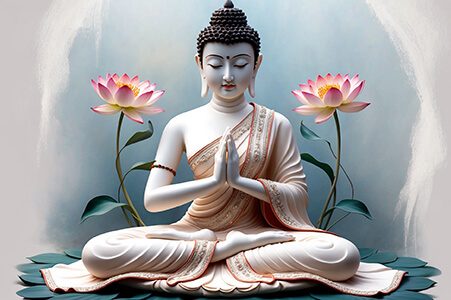
Pandaravasini Buddha: Amitabha Consort
Pandaravasini is a revered female Buddha in Vajrayana Buddhism, closely associated with wisdom, purity, and the enlightened qualities of the divine feminine. She is part of the Five Wisdom Dakinis and is linked to the Padma (Lotus) family, which represents love, compassion, and pure perception.
Pandaravasini is the consort of Amitabha, one of the Five Dhyani Buddhas. The five Dhyani Buddhas are said to have existed since the beginning of time. They represent or symbolize divine principles or forces. They are self-born. The word dhyani is derived from the Sanskrit dhyana meaning “meditation.” The Dhyani Buddhas are also called Jinas, meaning Victors or Conquerors.
Share this page with a friend!
Watch nearly 400 videos on the Vocal Medicine Channel!
Padmadevi Mantra
The mantra of chant to Pandaravasini is the Padmadevi Mantra: Om Padmadevi Puspadevi Pam Svaha. Pandaravasini is also known as the Queen of the Lotus. “Pam” (pronounced puhm) is her seed syllable. “Padma” means “a lotus flower” and “devi” means a “goddess” or “queen.” “Pushpa” also means “flower.” The music for this mantra is by Kathleen Karlsen.
Symbols of Pandaravasini
Pandaravasini’s name means the White Robed One. This suggests that she is vested with purity. She is also associated with the color light red. Pandaravasini holds her hands together at her breast in the anjali mudra, and is clasping the stems of two lotuses. On the lotus at her left shoulder rests a vajra bell.
On the lotus at her right shoulder rests a vase of immortality. The lotus symbolizes spiritual awakening and the blossoming of enlightenment. Sometimes Pandaravasini wears a crown of five jewels, representing the five wisdoms in Buddhism. She is usually seated in a graceful, meditative pose.
Role of Pandaravasini
Pandaravasini appears in various Buddhist traditions as an emanation of wisdom and compassion. She often works to guide sentient beings toward enlightenment. She has less commonly described stories when compared to more well-known figures like the Goddess Tara. However, she plays an essential role in esoteric Buddhist teachings, particularly in Vajrayana.
Moving from Ignorance to Wisdom
In some interpretations, Pandaravasini embodies the transformative power of spiritual perception, helping practitioners move from ignorance to wisdom. She is also sometimes linked to White Tara, another important female deity known for healing and longevity.
Consort of Amitabha Buddha
Her association with Amitabha Buddha, the central figure of Pure Land Buddhism, signifies her role in guiding beings toward rebirth in the Western Pure Land. By invoking Pandaravasini’s wisdom, devotees seek to develop the enlightened qualities necessary for liberation from the cycle of birth and death.
Complementary Roles
Amitabha Buddha, one of the five Dhyani Buddhas, represents infinite light and boundless compassion. He presides over Sukhavati, the Pure Land, a realm where beings can attain enlightenment free from suffering. As his spiritual consort, Pandaravasini complements his wisdom with feminine insight and purity.
Buddhist Iconography
In Buddhist iconography, they symbolize the perfect union of wisdom (Prajna) and compassion (Karuna)—a fundamental concept in Mahayana Buddhism. While Amitabha embodies the infinite light of compassion, Pandaravasini embodies the pure perception and clarity that leads to enlightenment.
Pandaravasini Article Summary
Pandaravasini is a revered female Buddha in Vajrayana Buddhism, closely associated with wisdom, purity, and the enlightened qualities of the divine feminine. She is part of the Five Wisdom Dakinis and is linked to the Padma (Lotus) family. Learn more about this beautiful female buddha!
Click for all content on our Site Map
Author Kathleen Karlsen
Kathleen Karlsen is a musician, artist, writer and speaker. She is the author of two books (Flower Symbols and Vocal Medicine) and over 200 articles. Kathleen, her husband Andrew, and their five children live in Bozeman, Montana. More about Kathleen Karlsen.





